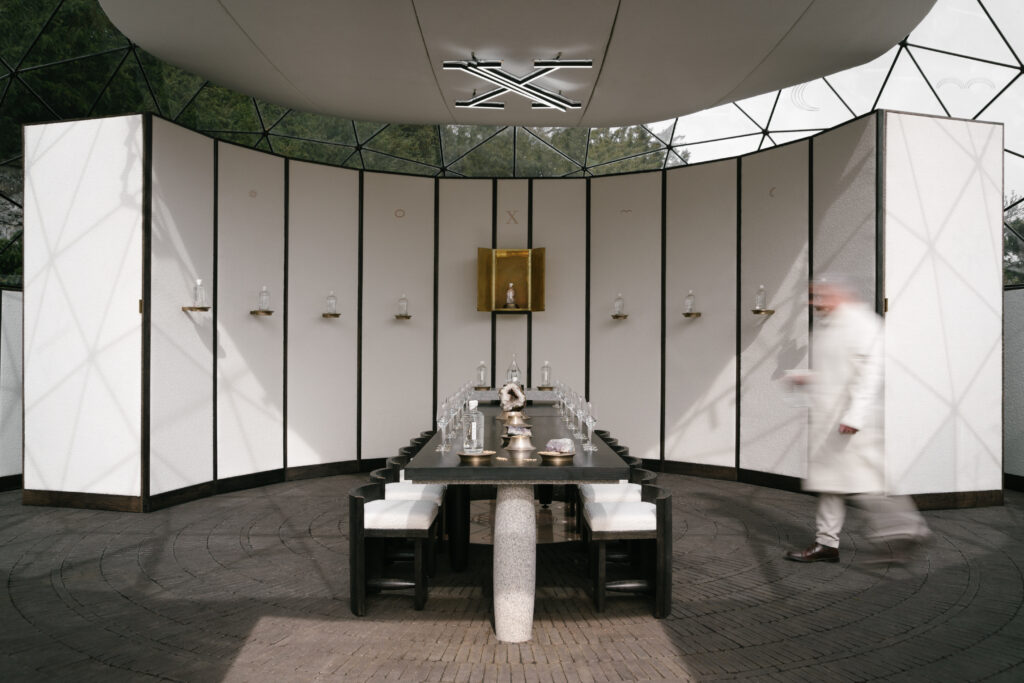
X Muse: a vodka that tips its hat to Scotch whisky
In his final blog post for The Grape & The Grain, Peter Ranscombe visits Jupiter Artland near Edinburgh to try its new X Muse vodka.
IT’S not every day that you taste a vodka inside a temple.
But, then again, it’s not every day that you taste a vodka that’s made like X Muse.
The white spirit was created by Robert Wilson, who opened sculpture park Jupiter Artland near Edinburgh in 2009 with his wife, Nicky.
He teamed up with his business partner, Vadim Grigoryan, a former director at Pernod Ricard, the French drinks giant that owns Chivas Brothers, Scotland’s second-largest whisky distiller.
The pair had collaborated in the past on projects that combined the worlds of drinks and design, and decided to make a vodka together.
X Muse isn’t just any old vodka though – it’s a blended barley vodka.
Here’s a quick recap – vodka can be made from, pretty much, anything.
Grains such as barley, rye, and wheat – along with tatties – were the original mainstay in Eastern Europe, but these days maize, milk, molasses, and even grapes are used as vodka’s raw material.
As long as you can find a yeast to convert the sugar to alcohol then you’re good to go.
Malted barley is at the more-expensive end of that spectrum, which hints at X Muse’s quality credentials.
Wilson and Grigoryan enlisted the help of Holyrood distillery in Edinburgh for its new make spirit, which is then rectified at Moorland Spirit in Northumbria to get it up to vodka’s required alcoholic strength.
Eventually, the pair wants to grow barley in the fields surrounding Jupiter Artland and build a distillery.

A tasting in a temple
Back to that temple now.
Wilson and Grigoryan also wanted to create a look and feel for the brand that would match the quality of their liquid.
Formafantasma – the Milan-based design studio behind the central pavilion at this year’s Venice Biennale cultural exhibition – was drafted in to create a tasting room or “temple” at Jupiter Artland, next to the colourful tiles of its swimming pool.
The tasting room sits inside a geodesic dome that was previously home to the swimming pool’s changing rooms, and includes a water bowl and bottle stands made by Powderhall Bronze in Edinburgh.
Visitors to Jupiter Artland can book a tasting until 30 September, during which they can not only try X Muse vodka, but also the spirits made from the two individual barley varieties used in its blend, Maris Otter and Plumage Archer.
For me, the Maris Otter – a variety from the 1960s still favoured by traditional beer brewers – produced the more intereting vodka of the two, with lemon and lime aromas dancing among the grain notes on the nose, with lots of pear and vanilla on the palate, alongside a rounded texture.
In contrast, the vodka made with the Plumage Archer – an Edwardian variety that became the backbone for many 20th century India pale ales – gave more baby sick and rice pudding on the nose, before launching into a palate full of banana, red and green apples, and apple compote, although its alcohol was better integrated, delivering a smoother finish.
Those two sets of characteristics came together to form the X Muse blended barley vodka (£55, xmusevodka.com), with pear drops on the nose and then spicy cinnamon and sharper cider apple on the palate.
It’s the texture that’s most impressive though, and which earns X Muse a place alongside other excellent modern Scottish vodkas, such as Puffing Billy steam vodka from The Borders Distillery and Eight Lands’ organic vodka from Glenrinnes Distillery on Speyside.
Wilson and Grigoryan spent three years developing their recipe and auditioned about 30 varieties of malt, including Chevallier and Orkney’s famous Bere barley, which produced a vodka that was “too vegetal”.
And the name? Wilson and Grigoryan drew on inspiration from Scottish poet-turned-artist Ian Hamilton Finlay – whose work sits in Jupiter Artland – and the nine muses of Greek mythology.
Their vodka is the “tenth muse” – although “Xth Muse” perhaps wouldn’t have looked quite as stylish as “X Muse” does on the label.
Read Peter’s previous blog entries for The Grape & The Grain.
Plus, don’t miss new drinks blogger James Robertson’s first article.
TAGS

